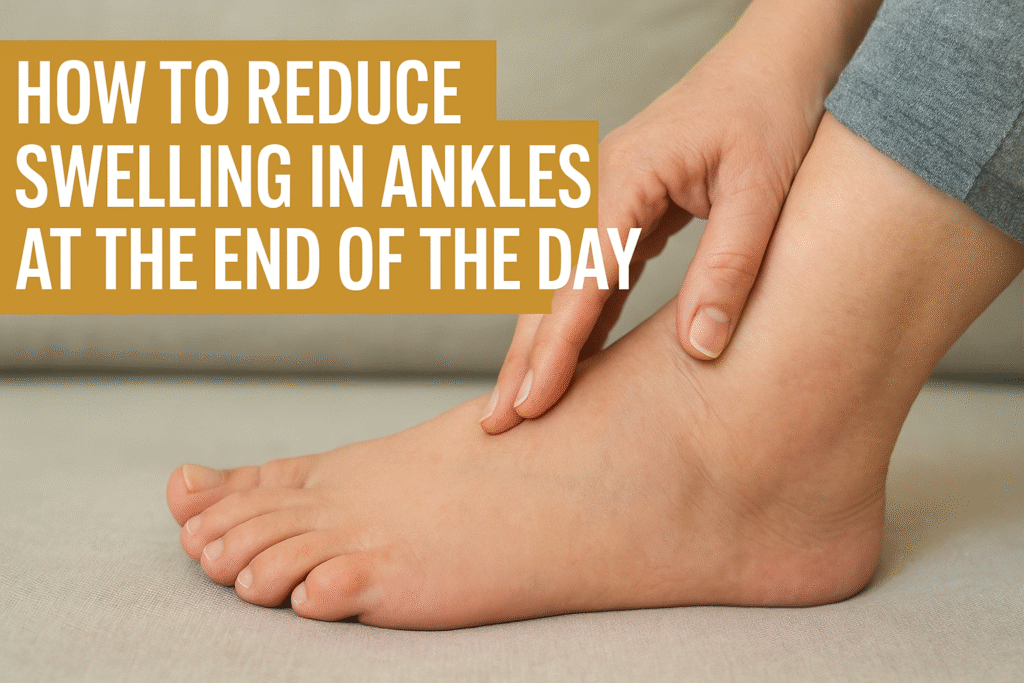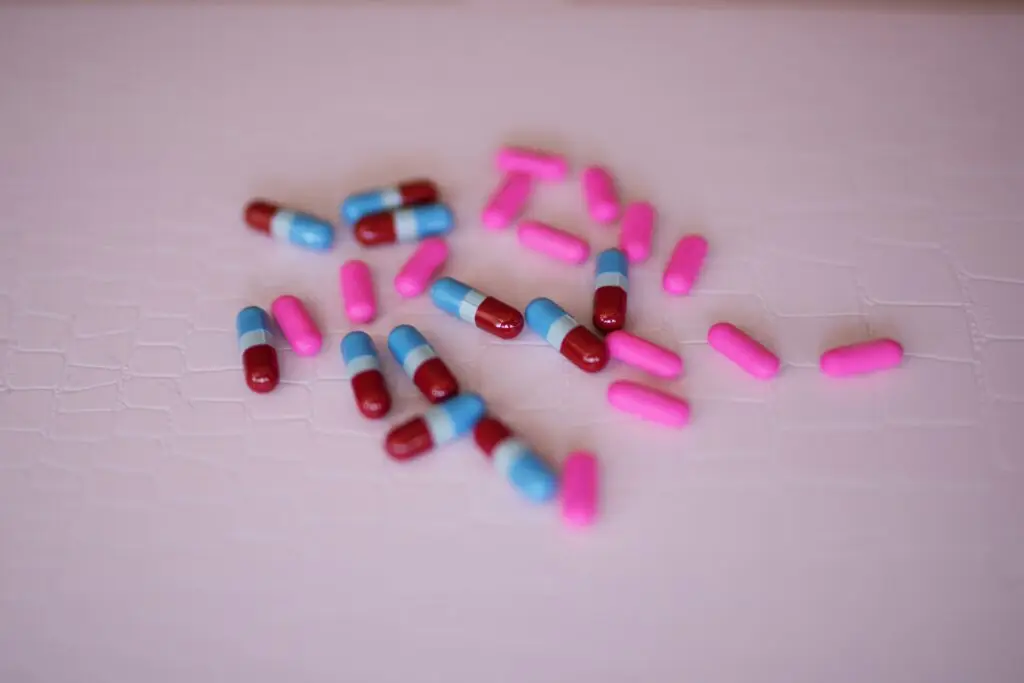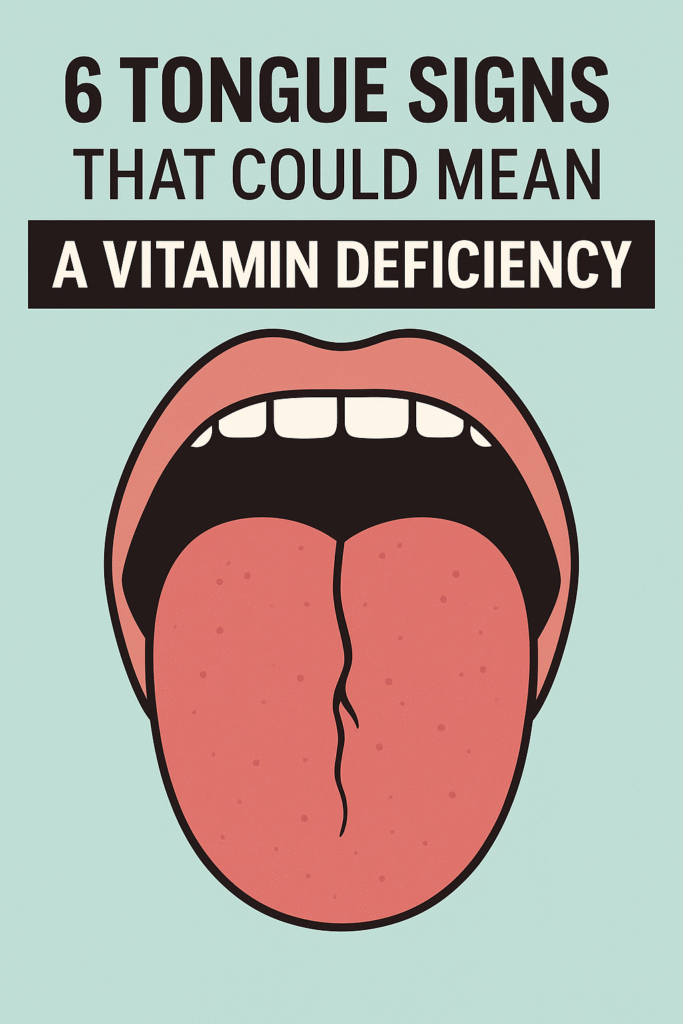
⚠️ Affiliate Disclaimer: This post may contain affiliate links, which means I may earn a small commission — at no extra cost to you — if you make a purchase through one of these links. I only recommend products or services I genuinely trust and believe can provide value. Thank you for supporting My Medical Muse!
10 Proven Ways to Reduce Swelling in Ankles at the End of the Day
How to Reduce Swelling in Ankles at the End of the Day
Swelling in the ankles after a long day is a common concern for many people, whether you’ve been standing at work, sitting at a desk for hours, or traveling, your ankles may feel heavy, tight, and puffy by the evening.
This condition, medically known as edema, develops when excess fluid collects in the soft tissues of the lower legs, while occasional swelling is often harmless, it can feel uncomfortable and sometimes signal an underlying health issue. The good news is that there are many simple, effective ways to relieve swollen ankles and prevent them from becoming a daily problem.
In this in-depth guide, we’ll explore:
- Why ankle swelling happens
- The most common causes and risk factors
- Quick relief strategies you can use after a long day
- Long-term lifestyle changes to prevent swelling
- When swelling may indicate a more serious medical condition
- Practical FAQs
By the end, you’ll have a clear, practical toolkit for keeping your ankles comfortable, healthy, and swelling-free.
Understanding Ankle Swelling
Ankle swelling, or peripheral edema, happens when fluid leaks from the blood vessels into the surrounding tissues because of gravity, the fluid naturally collects in the lowest parts of the body, your feet and ankles especially after long periods of sitting or standing.
The swelling can look and feel different depending on the cause and severity:
- Mild swelling: Your ankles may feel puffy, slightly heavy, or tender by the evening but improve after rest.
- Moderate swelling: The skin may appear shiny, stretched, or tight, making shoes feel snugger than usual.
- Pitting edema: If you press gently into the swollen area with a finger, it leaves a temporary indentation before slowly springing back.
For most people, occasional ankle swelling is temporary and improves with home remedies like leg elevation, hydration, or reducing salt intake. However, persistent or severe swelling should not be ignored. It can sometimes be a warning sign of an underlying condition such as:
- Circulatory problems (like varicose veins or venous insufficiency, where blood struggles to flow back to the heart).
- Kidney issues that interfere with fluid regulation.
- Heart conditions, such as heart failure, which cause fluid to build up in the lower body.
- Liver disease, where reduced protein production affects how fluids move in and out of blood vessels.
Recognizing whether your ankle swelling is simply lifestyle-related (too much standing, salty foods, hot weather) or linked to a medical problem is key. Paying attention to when the swelling occurs, how long it lasts, and whether it’s accompanied by pain, redness, or shortness of breath can help you decide if simple self-care is enough or if you should consult a doctor.
Common Causes of Swollen Ankles at the End of the Day
Swelling in the ankles doesn’t happen without a reason. Understanding the underlying cause is the first step to managing it effectively. Below are the most common factors that contribute to ankle swelling by evening.
1. Prolonged Standing or Sitting
When you stay in one position for hours, whether standing behind a counter, sitting at a desk, or traveling, circulation in your legs slows down. Gravity pulls blood and fluid toward the lower legs, and without regular movement, it tends to pool around the ankles and feet.
2. Heat and Humidity
Hot weather naturally causes blood vessels to expand (a process called vasodilation). This makes it easier for fluid to leak into surrounding tissues, which explains why ankle swelling is more common in the summer or after spending time in warm environments.
3. High Salt Intake
Sodium plays a major role in how your body manages fluids. Eating too much salt, often hidden in processed foods, canned soups, sauces, and snacks makes your body hold on to extra water. This retention often shows up as swelling in the ankles, feet, and sometimes the hands.
4. Medications
Certain medications list fluid retention as a side effect. Common culprits include:
- Blood pressure medications (such as calcium channel blockers)
- Steroids (like prednisone)
- Hormonal therapies (estrogen, progesterone, or testosterone)
- Antidepressants
If you notice swelling after starting a new prescription, it’s worth discussing with your doctor.
5. Pregnancy
Swollen ankles are very common during pregnancy due to several factors, increased blood volume, hormonal changes that affect blood vessels, and pressure from the growing uterus on the veins in the pelvis. Swelling usually becomes more noticeable in the second and third trimesters.
6. Being Overweight
Excess body weight increases the pressure on your veins, particularly in the legs. Over time, this strain can make it harder for blood to circulate efficiently, leading to fluid buildup and ankle swelling.
7. Injuries
An ankle sprain, strain, or fracture often causes swelling localized to the affected joint. In this case, the swelling is part of the body’s natural healing response, usually accompanied by pain, bruising, or limited movement.
8. Medical Conditions
Sometimes, ankle swelling is a symptom of an underlying health issue. These conditions may require medical attention:
- Varicose veins: Weakened or damaged vein valves cause blood to pool, leading to swelling, heaviness, and aching in the legs.

- Heart failure: When the heart cannot pump blood effectively, fluid accumulates in the lower body, often in the ankles and feet.
- Kidney disease: Impaired kidney function affects the body’s ability to filter excess fluid, resulting in swelling.
- Liver disease: The liver produces proteins that help regulate fluid balance. When protein levels drop, fluid can leak into tissues, including the ankles.
- Blood clots (deep vein thrombosis, DVT): A clot in a leg vein can suddenly block blood flow, causing swelling, redness, and pain in one leg. This is a medical emergency and requires immediate attention.
Immediate Relief: How to Reduce Ankle Swelling After a Long Day
If your ankles feel swollen and uncomfortable at night, you don’t have to wait until morning for relief. These simple strategies can help reduce swelling quickly and restore comfort before bedtime.
1. Elevate Your Legs
One of the fastest ways to reduce swelling is to let gravity help. Lie down and prop your legs up on pillows so your feet are above heart level for 15-20 minutes. This position encourages fluid to drain back toward your heart instead of pooling in the ankles. For extra benefit, try doing this a couple of times in the evening, such as when watching TV or reading.
2. Apply Cold Compresses
Cool temperatures help constrict blood vessels and reduce inflammation. Wrap an ice pack or a bag of frozen peas in a thin towel and place it on your swollen ankles for 10-15 minutes. This can ease discomfort, soothe tired muscles, and minimize puffiness. Avoid placing ice directly on the skin, as this can cause irritation or frostbite.
3. Gentle Massage
Massaging your ankles and calves in upward strokes (toward the heart) stimulates circulation and helps your lymphatic system move excess fluid away from the tissues. You can use your hands, a massage roller, or even a moisturizing lotion or oil to make the massage more comfortable. Keep the pressure light to moderate, especially if the swelling is tender.
4. Wear Compression Socks
Graduated compression stockings apply gentle pressure to your lower legs, preventing fluid from pooling and encouraging blood to flow upward. They are especially helpful if you know you’ll be sitting or standing for long periods the next day. Choose a pair with the right level of compression for your needs, your pharmacist or doctor can guide you.
5. Move Your Ankles and Feet
Simple, gentle exercises can activate your calf muscles, which act as “pumps” to move blood and fluid back up the legs. Try:
- Ankle circles: Rotate each ankle clockwise and counterclockwise 10-15 times.
- Toe points and flexes: Point your toes forward, then pull them back toward your shins. Repeat 10-15 times.
- Calf raises: Stand up and slowly lift your heels off the ground, then lower them. Do 10-15 repetitions.
These exercises can be done almost anywhere and provide quick relief by improving circulation.
Long-Term Lifestyle Changes to Prevent Ankle Swelling
If swollen ankles are a frequent problem, making simple lifestyle adjustments can help reduce how often it happens or even prevent it altogether.
1. Stay Active Throughout the Day
Movement is key to healthy circulation. If you sit at a desk, aim to stand and stretch every hour. If your job requires long hours of standing, shift your weight frequently and take short walking breaks to keep blood flowing. Even small movements, like flexing your feet under the desk, can make a difference.
2. Exercise Regularly
Low-impact activities such as walking, swimming, cycling, or yoga strengthen your leg muscles and veins. Stronger muscles improve circulation and help push blood and fluid back toward the heart. Aim for at least 30 minutes of activity most days of the week.
3. Watch Your Salt Intake
Excess sodium is one of the leading dietary causes of water retention. Processed foods, canned soups, sauces, and salty snacks are often high in hidden salt. Try cooking with fresh ingredients and using herbs, spices, or lemon juice instead of extra salt to flavor your meals.
4. Drink Plenty of Water
It may sound counterintuitive, but staying hydrated actually prevents fluid retention. When you don’t drink enough water, your body holds onto fluids as a defense mechanism. Aim for 6-8 glasses of water daily, adjusting for your activity level and climate.
5. Maintain a Healthy Weight
Even modest weight loss can ease pressure on your veins and improve blood flow. If you’re overweight, losing just 5-10% of your body weight can make a noticeable difference in how often your ankles swell.
6. Choose Supportive Footwear
Shoes that are too tight, narrow, or high-heeled can restrict circulation and worsen ankle swelling. Opt for comfortable, supportive shoes with good arch support. If you stand a lot at work, cushioned insoles may also help reduce strain.
7. Limit Alcohol
Alcohol can dehydrate your body and make fluid retention worse. Limit your intake and balance any drinks with plenty of water. Moderation is key.
8. Sleep with Legs Slightly Elevated
A small adjustment to your sleeping position can make mornings more comfortable. Place a pillow under your calves or feet so your legs rest slightly above heart level. This gentle elevation helps reduce overnight swelling and improves circulation while you sleep.
When to See a Doctor
In many cases, ankle swelling is temporary and responds well to home remedies. However, it’s important to recognize when swelling may be a sign of something more serious. You should seek medical attention promptly if you experience:
- Sudden or severe swelling in one leg: This may signal a blood clot (deep vein thrombosis, DVT), which requires immediate treatment to prevent complications.
- Swelling with redness, warmth, or pain: Could indicate infection or inflammation that needs medical care.
- Shortness of breath, chest pain, or palpitations: These symptoms, combined with ankle swelling, may point to a heart condition such as heart failure and require urgent evaluation.
- Persistent swelling that doesn’t improve with rest: Chronic swelling may be linked to circulation issues, kidney problems, or liver disease.
- Swelling with rapid weight gain: Especially if combined with fatigue or shortness of breath, this may signal fluid buildup from heart or kidney conditions.
Your doctor may perform tests such as blood work, urine analysis, ultrasounds, X-rays, or heart function evaluations to determine the cause and recommend the right treatment. Early diagnosis is key to preventing complications.
Natural Home Remedies for Swollen Ankles
Along with lifestyle adjustments, many people find comfort in simple, natural remedies that can be done at home. These options may help reduce inflammation, improve circulation, and provide soothing relief:
1. Epsom Salt Foot Soak
Soaking your feet in warm water mixed with Epsom salt can ease swelling, relax tired muscles, and improve circulation. Add ½ to 1 cup of Epsom salt to a basin of warm water and soak your feet for 15-20 minutes.
2. Magnesium-Rich Foods
Low magnesium levels may contribute to water retention. Including magnesium-rich foods like bananas, spinach, almonds, cashews, avocados, and pumpkin seeds can support fluid balance naturally. Some people may also benefit from magnesium supplements, but it’s best to consult a healthcare provider first.
3. Herbal Teas
Certain herbal teas act as mild diuretics, helping the body flush out excess fluid. Dandelion tea, in particular, has traditionally been used to reduce bloating and swelling. Chamomile tea can also promote relaxation, which may indirectly help with fluid regulation.
4. Essential Oils
Massaging diluted essential oils into swollen ankles can provide a soothing effect. Peppermint oil offers a cooling sensation, while lavender oil promotes relaxation. Mix a few drops with a carrier oil like coconut or olive oil before applying it to the skin.
5. Cooling Foot Bath
If swelling is accompanied by heat or discomfort, soaking your feet in a basin of cool (not ice-cold) water for 10-15 minutes can constrict blood vessels and ease puffiness.
6. Gentle Yoga Poses
Simple yoga postures such as Legs-Up-the-Wall (Viparita Karani) encourage fluid to drain from the legs, relieving swelling and promoting relaxation.
FAQs About Ankle Swelling
1. Why do my ankles swell only at night?
This happens because of gravity and circulation. During the day, when you’re standing or sitting for long periods, blood and fluid naturally pool in the lower legs. By evening, this buildup becomes noticeable as swelling. Once you lie down to rest, circulation improves, and swelling often decreases overnight.
2. Can dehydration cause ankle swelling?
Yes, indirectly. When you don’t drink enough water, your body holds on to whatever fluid it has left, a process called fluid retention. This can lead to puffiness in the ankles, feet, or hands. Staying well-hydrated actually helps prevent swelling by flushing out excess sodium and supporting healthy circulation.
3. Are swollen ankles always a sign of poor circulation?
Not necessarily, while poor circulation and conditions like varicose veins can cause swelling, ankles may also swell due to heat, pregnancy, certain medications, dietary salt, injuries, or even standing too long. The key is to look at accompanying symptoms such as pain, redness, or shortness of breath, which may point to more serious issues.
4. Can exercise worsen swollen ankles?
It depends on the type and intensity of exercise. High-impact activities like running on hard surfaces may sometimes cause temporary ankle swelling, especially if you’re new to exercise or wearing unsupportive shoes. On the other hand, low- to moderate-impact exercises such as walking, swimming, cycling, or yoga usually help reduce swelling by boosting circulation and strengthening the muscles that support your veins.
5. Should I see a doctor if only one ankle swells?
Yes. One-sided swelling is often more concerning than swelling in both ankles. It could indicate an injury, infection, or a blood clot (deep vein thrombosis), which can be dangerous if left untreated. Always seek prompt medical advice if only one ankle is swollen, especially if it comes on suddenly or is painful.
6. Can diet affect ankle swelling?
Absolutely. Diets high in salt cause the body to retain more water, leading to noticeable swelling in the ankles and feet. Highly processed foods, canned soups, and fast food are common culprits. On the other hand, a balanced diet rich in fresh fruits, vegetables, lean proteins, and whole grains supports fluid balance and vein health.
7. Do compression socks really help?
Yes. Graduated compression socks apply gentle pressure to the lower legs, preventing fluid from pooling and improving blood flow back toward the heart. They’re especially helpful for people who sit, stand, or travel for long periods. Many find them to be one of the most effective daily preventive measures against ankle swelling.
Final Thoughts
Swollen ankles at the end of the day are often a result of simple factors like standing or sitting too long, hot weather, or high salt intake. In most cases, the swelling is temporary and can be managed with easy remedies such as elevating your legs, staying active, wearing supportive footwear, drinking plenty of water, and using compression socks.
However, it’s important to remember that persistent or sudden swelling, especially if it’s one-sided or comes with pain, redness, or shortness of breath, should never be ignored. These may be warning signs of an underlying medical condition that requires professional care.
By combining immediate relief techniques with long-term lifestyle habits, you can keep your ankles light, healthy, and comfortable helping you end each day on your feet without discomfort.
👩⚕️ Need Personalized Health Advice?
Get expert guidance tailored to your unique health concerns through MuseCare Consult. Our licensed doctors are here to help you understand your symptoms, medications, and lab results—confidentially and affordably.
👉 Book a MuseCare Consult NowRelated Blog Post You Might Like:
- Why Do My Legs Feel Heavy at Night? 10 Powerful Natural Relief Options
- Why Do I Keep Getting Canker Sores in My Mouth? 10 Powerful Fixes
- Why Do My Lips Peel Constantly? 10 Everyday Fixes That Truly Work
- 7 Powerful Reasons Why You Wake Up with Dry Mouth Even After Drinking Water
- 7 Proven Fixes for Neck Stiffness After Sleeping Wrong
- Why Do My Eyes Twitch Randomly? 12 Causes & Proven Everyday Fixes



